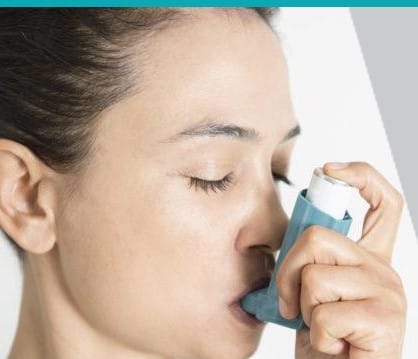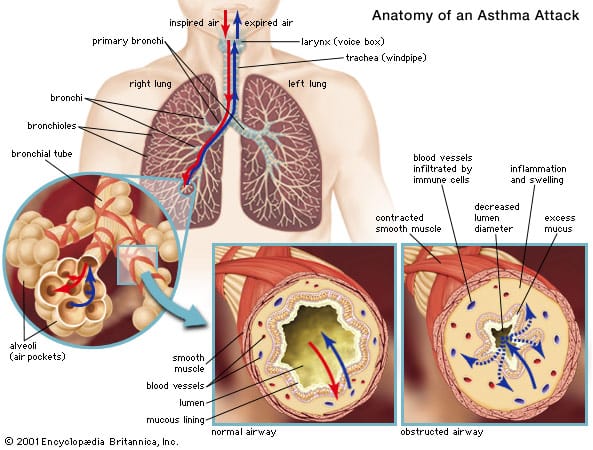Afternoon may be the optimal time for asthma inhalers

Homeocare
Dr Surya Kant
Mid-afternoon dosing of inhaled beclomethasone dipropionate taken once-daily between 3pm and 4pm significantly improved nocturnal lung function and inflammatory biomarkers (blood eosinophil counts) compared with once-daily morning and standard twice-daily dosing regimens without increasing steroid-related morbidity or treatment costs, according to a new study published April 15, 2025 in the journal Thorax.1
Researchers from the UK conducted this randomized, three-way crossover trial to assess the impact of inhaled corticosteroid dosing time on asthma control in 21 patients with mild to moderate atopic asthma. Participants were randomized to receive beclomethasone dipropionate in one of three regimens: 400 µg once daily in the morning between 8 AM and 9 AM (ODAM); 400 µg once daily in the afternoon between 3PM and 4PM (ODPM); or 200 µg twice daily, administered twice daily between 8AM and 9AM and between 8PM and 9PM (BD).
Each regimen was administered for 28 days, with a 2-week washout period between treatment phases. Six-hourly spirometry and biomarker assessments were conducted over a 24-hour period after the run-in phase and following each treatment period to evaluate physiological responses to different dosing schedules. Pulmonary function (primary endpoint), blood eosinophil counts, serum cortisol levels, reliever medication use and adverse events (secondary endpoints) were measured to evaluate outcomes.
The mid-afternoon dose (ODPM) showed superior improvement in evening lung function, with a median increase in FEV₁ at 22:00 of +160 mL, compared to -20 mL with ODAM and +80 mL with BD dosing. ODPM also demonstrated greater overnight suppression of blood eosinophil counts at 22:00 and 04:00 compared to ODAM and BD. All regimens improved asthma control and led to reductions in fractional exhaled nitric oxide (FeNO) and serum cortisol levels, with no significant differences observed between the three dosing schedules. No difference in reliever medication use and adverse events was observed among the dosing regimens. “Our findings further support the hypothesis that the optimal timing of ICS administration is at 16:00, coincident with enhanced glucocorticoid sensitivity at that time”, write the authors.
Nocturnal worsening of asthma symptoms is common and can sometimes be life-threatening. Based on the findings, the study concluded that afternoon dosing of inhaled corticosteroids (ODPM) more effectively improved nocturnal control compared to morning or twice-daily dosing. The simplified once-daily dosing without increase in adverse events suggests a role of chronotherapy in enhancing asthma management. However, larger studies are needed to validate these results in real-world settings and identify patients who may benefit most from chronotherapy.
Reference
1. Wang R, et al. The impact of dosage timing for inhaled corticosteroids in asthma: a randomised three-way crossover trial. Thorax. 2025 Apr 15:thorax-2024-222073. doi: 10.1136/thorax-2024-222073.
Dr Surya Kant is Professor and Head, Dept. of Respiratory Medicine, KGMU, UP, Lucknow. National Vice Chairman IMA-AMS

On World Asthma Day, WHO experts offer 5 tips on how to manage your asthma better.
1. Be aware of your symptoms
Cough, wheeze and difficulty breathing are all signs that your asthma is not well controlled. If you feel that your symptoms are getting worse, follow the instructions from your doctor. Use a reliever inhaler (e.g. salbutamol) with a spacer to open your airways.
2. Identify and avoid your triggers
Common triggers include smoke, fumes, viral infections, pollen, changes in the weather, animal fur and feathers, and strong fragrances. Know what affects you and try to avoid if possible. If not possible, make sure you have your reliever inhaler readily available.
3. Know your inhalers
A reliever inhaler (also called a bronchodilator) opens up the small airways and improves airflow in and out of the lungs. Use this when you have symptoms
A steroid or preventer inhaler reduces inflammation in the lungs and is an essential part of long term asthma treatment. By using a steroid inhaler, as directed by your doctor, you will improve your symptoms and reduce the risk of a severe attack.
Inhalers are the safest, most effective treatment for asthma and allow people with asthma to lead a normal, active life.
4. Use a spacer
A spacer is a plastic chamber which connects the inhaler at one end, to your mouth via a mouthpiece or mask at the other end. It can help inhaled medicines to reach the small airways in the lungs and work better. The spacer allows more time for the medicine to be breathed in and means that less coordination is required. Without a spacer, you have to breath in deeply and press the inhaler at the same time – inhaled medicine often ends up in the mouth or throat and is ineffective. Some types of inhaler (e.g. dry powder inhalers) do not need a spacer – check with your doctor if you are unsure.
5. Take back control
Knowledge is power. Ask your doctor to explain how your inhaled medicines work and how you should use them. Make sure your friends and family also know what to do if your asthma is bad. By taking your inhalers early, when you first notice that your symptoms are worsening, you can avoid a serious attack.
